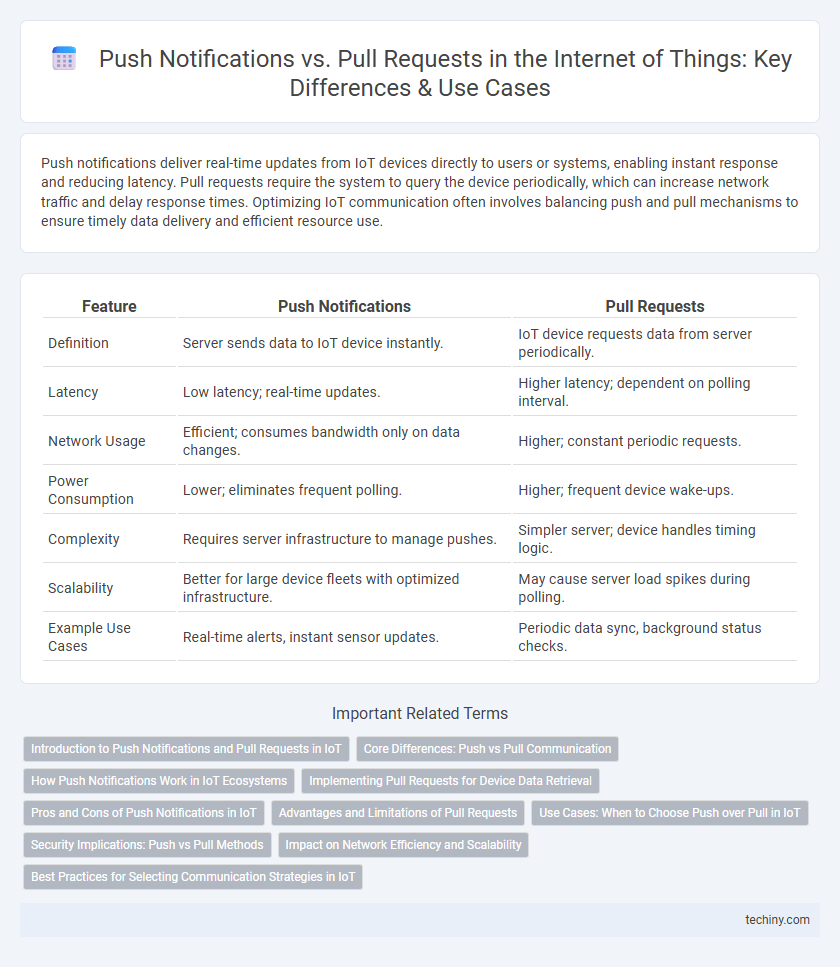Push notifications deliver real-time updates from IoT devices directly to users or systems, enabling instant response and reducing latency. Pull requests require the system to query the device periodically, which can increase network traffic and delay response times. Optimizing IoT communication often involves balancing push and pull mechanisms to ensure timely data delivery and efficient resource use.
Table of Comparison
| Feature | Push Notifications | Pull Requests |
|---|---|---|
| Definition | Server sends data to IoT device instantly. | IoT device requests data from server periodically. |
| Latency | Low latency; real-time updates. | Higher latency; dependent on polling interval. |
| Network Usage | Efficient; consumes bandwidth only on data changes. | Higher; constant periodic requests. |
| Power Consumption | Lower; eliminates frequent polling. | Higher; frequent device wake-ups. |
| Complexity | Requires server infrastructure to manage pushes. | Simpler server; device handles timing logic. |
| Scalability | Better for large device fleets with optimized infrastructure. | May cause server load spikes during polling. |
| Example Use Cases | Real-time alerts, instant sensor updates. | Periodic data sync, background status checks. |
Introduction to Push Notifications and Pull Requests in IoT
Push notifications in IoT enable devices to receive real-time alerts and updates from servers or other connected devices without continuous polling, enhancing responsiveness and reducing network traffic. Pull requests in IoT involve devices actively requesting data or updates from servers at specific intervals, providing control over timing but potentially increasing latency and power consumption. Understanding the trade-offs between push and pull communication methods is crucial for optimizing IoT performance, scalability, and energy efficiency.
Core Differences: Push vs Pull Communication
Push notifications in the Internet of Things (IoT) enable devices to send real-time data or alerts directly to users or other systems without waiting for a request, ensuring immediate updates and efficient event-driven communication. Pull requests require devices or applications to periodically query sensors or servers for data, which can introduce latency and increase network traffic due to continuous polling. Core differences include push's proactive data delivery versus pull's reactive data retrieval, affecting responsiveness, resource consumption, and scalability in IoT communication architectures.
How Push Notifications Work in IoT Ecosystems
Push notifications in IoT ecosystems function by sending real-time alerts from devices or sensors directly to user applications or platforms, enabling immediate response to events or data changes. These notifications are triggered by specific conditions or thresholds detected by IoT devices and are transmitted via protocols such as MQTT, CoAP, or HTTP/2. This mechanism minimizes latency and reduces the need for constant polling, thus optimizing network bandwidth and enhancing system efficiency in connected environments.
Implementing Pull Requests for Device Data Retrieval
Implementing pull requests for device data retrieval in Internet of Things (IoT) environments enhances control over data flow by allowing devices or applications to request specific information on demand. This approach reduces unnecessary network traffic and conserves device battery life compared to push notifications, which send data continuously regardless of immediate need. By leveraging pull requests, IoT systems can efficiently manage bandwidth and improve real-time data accuracy, crucial for applications like smart homes and industrial monitoring.
Pros and Cons of Push Notifications in IoT
Push notifications in IoT offer real-time data delivery, enabling instant alerts and rapid response to critical events, which enhances device interoperability and user experience. However, they may lead to increased power consumption in battery-operated devices and risk overwhelming users with frequent or irrelevant alerts. Despite these drawbacks, push notifications remain vital for time-sensitive applications such as security monitoring and emergency systems.
Advantages and Limitations of Pull Requests
Pull requests in the Internet of Things (IoT) enable devices to request data only when needed, reducing unnecessary network traffic and conserving energy resources. This approach enhances security by limiting data exposure but can introduce latency due to the polling intervals required for data retrieval. However, pull requests may strain device resources when frequent polling is necessary, potentially impacting battery life and performance in constrained IoT environments.
Use Cases: When to Choose Push over Pull in IoT
Push notifications are ideal in IoT scenarios requiring immediate alerts, such as security breaches or critical system failures, ensuring real-time response without device polling. Pull requests suit periodic data collection in energy management or environmental monitoring, where devices fetch updates at scheduled intervals to conserve power. Choosing push enhances efficiency in time-sensitive applications, while pull optimizes resource usage in less urgent, data-driven tasks.
Security Implications: Push vs Pull Methods
Push notifications in Internet of Things (IoT) enable real-time data delivery but may increase exposure to unauthorized access if endpoints are compromised, requiring robust authentication and encryption protocols. Pull requests allow devices to retrieve data on demand, minimizing continuous open connections, and reducing the attack surface for potential breaches. Implementing secure communication channels like TLS and validating data sources are critical for both push and pull methods to safeguard IoT ecosystems against interception and spoofing threats.
Impact on Network Efficiency and Scalability
Push notifications in Internet of Things (IoT) enable devices to receive real-time updates without continuous polling, significantly reducing network traffic and improving efficiency. Pull requests, requiring devices to frequently query servers, increase latency and bandwidth consumption, posing challenges for large-scale deployments. Scalability is enhanced by push mechanisms as they minimize redundant data transmission, conserve device resources, and support large IoT networks with diverse device types and connectivity conditions.
Best Practices for Selecting Communication Strategies in IoT
Push notifications offer real-time, event-driven communication that conserves bandwidth and reduces latency, making them ideal for urgent IoT alerts and status updates. Pull requests provide on-demand data retrieval, suitable for power-sensitive devices requiring periodic information to avoid unnecessary transmissions. Best practices in selecting communication strategies for IoT involve balancing device energy constraints, network reliability, and data urgency to optimize overall system efficiency and responsiveness.
Push notifications vs Pull requests Infographic

 techiny.com
techiny.com